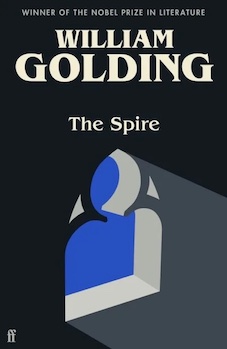The Spire, published on 10th April 1964, is celebrating its 60th anniversary today! It was Golding’s fifth novel, and his first of the 1960s. His first four novels, with Lord of the Flies as his debut, were written and published within an astonishing five-year period in the 1950s, marking his arrival as one of the great contemporary British novelists. This success allowed him to become a full-time writer and leave his job as a schoolteacher in Salisbury. But his experiences in Salisbury – and most particularly the view of the spire of the cathedral, visible from the window of his classroom – inspired his 1964 masterpiece.
The writing of The Spire was difficult for Golding. His daughter Judy Golding, and dedicatee of the novel, notes that:
‘Writing The Spire cost my father much time, effort, and anguish. He started off with three or four stories. Over some years he rigorously pruned them down to one: the story of Dean Jocelin’s inspired yet destructive obsession with placing a spire on a cathedral.’
The initial idea came in 1959, shortly after the publication of Free Fall, although Golding aimed to write something funny, not ‘savage/tragic’ (Carey, 250). By 1961, Golding had completed the introduction from the point of view of a twentieth-century narrator, but by the time he sent Faber the typescript in 1963, the novel was firmly set in the Middle Ages. Despite Faber editor Charles Monteith’s positive response, Golding continued to re-draft the story until its publication in 1964. The Spire was a bestseller in both the UK and the US.
Sixty years later, what does The Spire offer to twenty-first-century readers? I’ve written previously about the experience of reading The Spire for the first time, and also about the pleasure of teaching the book to a group of English Literature undergraduates. Now, in 2024, the sheer beauty of Golding’s language to describe the construction of the spire, to elucidate the strain – physical and metaphorical – that Jocelin’s obsession causes, and to emphasise the complexity of human relationships, stands out as timeless and eternal. The indeterminacy of narrative and the self-conscious shifts in perspective creates a story that could be published now, in our current age of historical fiction. Indeed, as author Benjamin Myers writes in his introduction to the 2021 edition: ‘it is a novel whose themes, I’d wager, will still be recognisable to readers in five hundred years’ time.’ Ten years after The Spire’s publication, while Golding was preparing to talk to give a talk about the cathedral’s spire, Golding wrote in his unpublished journal: ‘the spire is unexpected all the way up, and finally wholly unexpected in its beauty.’ He could easily have been describing the novel itself.
